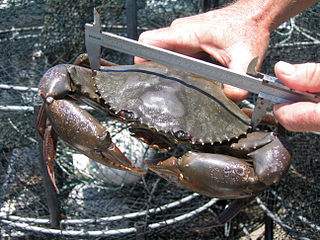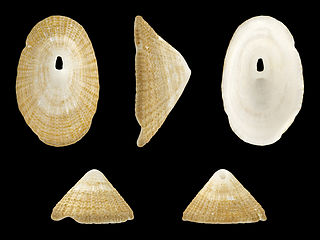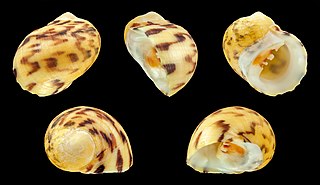
Sylla serrata is an ecologically important species of crab found in the estuaries and mangroves of Africa, Australia, and Asia. In their most common forms, their shell colours vary from a deep, mottled green to very dark brown.

The sooty oystercatcher is a species of oystercatcher. It is a wading bird endemic to Australia and commonly found on its coastline. It prefers rocky coastlines, but will occasionally live in estuaries. All of its feathers are black. It has a red eye, eye ring and bill, and pink legs.

Notolabrus fucicola, the banded parrotfish, blue wrasse, kelpie, New Zealand banded wrasse, purple parrotfish, saddled wrasse, Southern purple wrasse, Southern wrasse, winter bream or yellow-saddled wrasse, is a species of wrasse native to the eastern Indian Ocean, off eastern Australia and all around New Zealand on rocky, weedy reef areas. Aging work in New Zealand suggested these wrasses can live at least 35 years.

Diodora cayenensis, the Cayenne keyhole limpet, is a species of small to medium-sized sea snail or limpet, a western Atlantic marine prosobranch gastropod mollusk in the family Fissurellidae, the keyhole limpets.

Dicathais is a genus of predatory sea snails, marine gastropod molluscs in the family Muricidae, the rock snails. This genus is monotypic; the only species in it is Dicathais orbita, common name the white rock shell or cart-rut shell, found round the coasts of Australia and New Zealand.

Neritidae, common name the nerites, is a taxonomic family of small to medium-sized saltwater and freshwater snails which have a gill and a distinctive operculum. The family Neritidae includes marine genera such as Nerita, marine and freshwater genera such as Neritina, and freshwater and brackish water genera such as Theodoxus.

Nerita melanotragus, common name black nerite, is a medium-sized sea snail, a marine gastropod mollusc in the family Neritidae, the nerites.

Pagurus hirsutiusculus is a species of hermit crab, commonly called the hairy hermit crab. It lives from the Bering Strait south to California and Japan, from the intertidal zone to a depth of 110 m (360 ft).

Nerita tessellata, sometimes known as the checkered nerite, is a species of tropical sea snail with a gill and an operculum, a nerite, a marine gastropod mollusk in the family Neritidae, the nerites.

Nerita plicata is a species of tropical sea snail, a marine gastropod mollusk in the family Neritidae, the nerites. This species is found throughout the Indo-West Pacific.

Tenguella granulata, common name the mulberry shell or the granulated drupe, is a species of sea snail, a marine gastropod mollusk in the family Muricidae, the murex snails or rock snails.

Nucella lamellosa, commonly known as the frilled dogwinkle or wrinkled purple whelk, is a species of sea snail, a marine gastropod mollusk in the family Muricidae, the murex snails or rock snails. This species occurs in the eastern Pacific Ocean, its range extending in the intertidal zone from the Aleutian Islands southward to central California.

Nerita albicilla, common name the blotched nerite, is a species of sea snail, a marine gastropod mollusk in the family Neritidae.

Nerita aterrima is a species of sea snail, a marine gastropod mollusk in the family Neritidae.

Nerita chamaeleon is a species of sea snail, a marine gastropod mollusk in the family Neritidae.

Nerita peloronta, common name the "bleeding tooth", is a species of sea snail, a marine gastropod mollusc in the family Neritidae.

Nerita textilis, common name the textile nerite, is a species of sea snail, a marine gastropod mollusk in the family Neritidae.
Hypothalassia acerba is a large crab found in the muddy substrates of the deep seas off the southwestern Australian and New Zealand coasts. Australian distribution, which is correlated to depth and temperature, ranges from a latitude as far north as approximately 27° S on the west coast, southwards, then eastwards on the south coast to a longitude of at least 129° E. The species usually occurs in waters with temperatures of 13–19 °C (55–66 °F) and in depths ranging of 200–255 metres (656–837 ft) on the lower west coast and 90–200 m (300–660 ft) on the south coast. Body size is inversely related to depth of water. There are only two species in the genus Hypothalassia, and H. acerba is not the same champagne crab as the other Hypothalassia species, H. armata, which is found in Japanese waters.

Tenguella marginalba is a species of sea snail, a marine gastropod mollusc in the family Muricidae, the murex snails or rock snails. It is commonly known as the mulberry whelk and is found in shallow waters in the Indo-Pacific and around the north and east coasts of Australia.

Nerita Picea, also called Black Nerite or Pipipi in Hawaiian, is a species of marine gastropod mollusc in the family Neritidae commonly found in clusters on the high part of the intertidal zone. This species is found all throughout the Hawaiian coastline and is endemic to the Hawaiian Islands. In Hawai‘i black nerite are enjoyed as a snack when boiled.



















